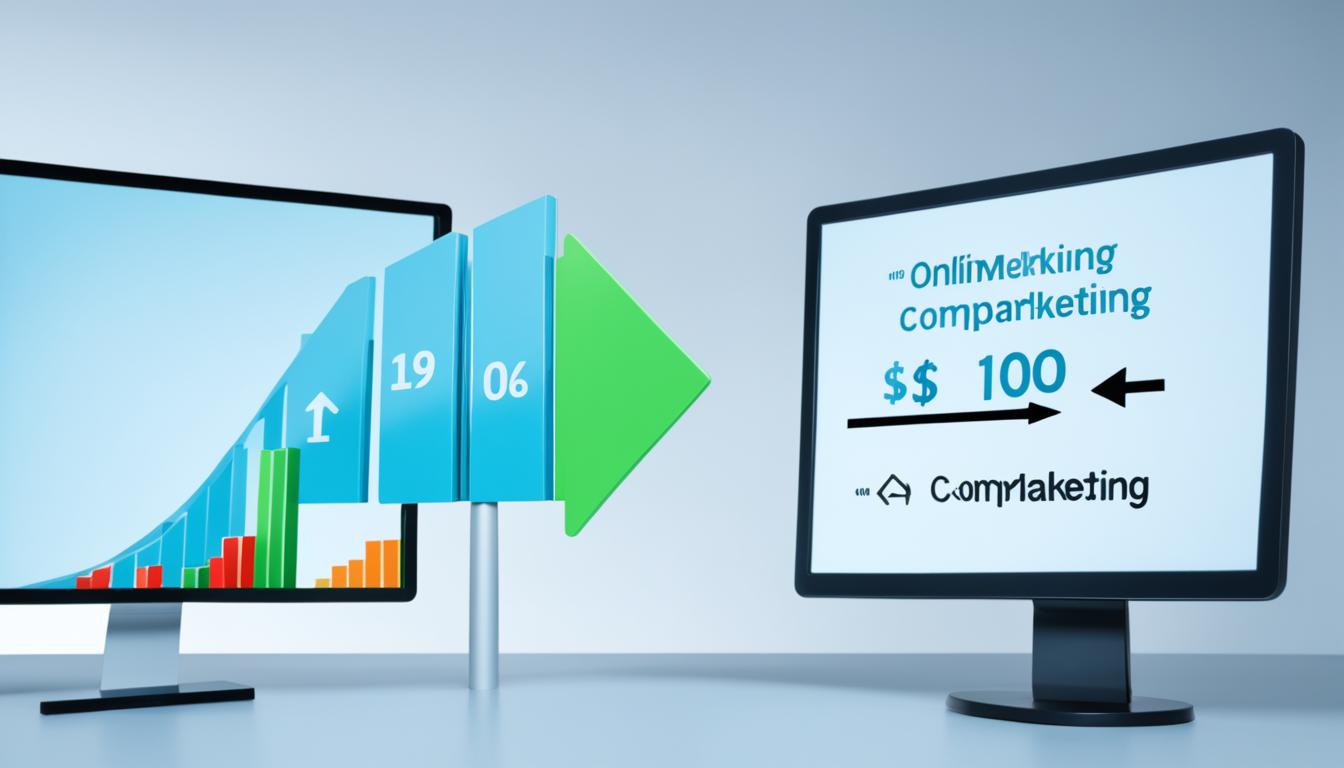Psychographics in marketing helps businesses understand their customers better. This approach studies consumer behavior and preferences. It allows companies to engage with people personally and improve their marketing.
Studying consumer behavior is key in this process. It looks at what people value, desire, their interests, and how they live. Knowing these things helps businesses reach out in ways that truly speak to their audience. It can make a big difference in influencing what people buy.
Profiling the target audience is also crucial. This means looking at groups of consumers who share similar views and ways of living. It makes it easier for companies to meet the specific needs and wants of different groups.
Creating buyer personas is a direct use of psychographics. These are detailed customer profiles based on real data and insights. They show businesses what drives their customers, what problems they face, and how they decide to buy things. This leads to more personalized marketing that hits the mark.
Understanding consumer values and attitudes is vital, too. It’s about knowing what’s important to people and why they do what they do. Companies can then make sure their messages and brand fit with what their customers believe in.
Overall, psychographics offer a full view of consumer behavior and choices. By adding psychographic insights to demographic information, businesses can create detailed profiles of their buyers. This helps in crafting marketing that really connects with people.
Key Takeaways:
- Psychographics in marketing focus on understanding the psychological characteristics of consumers.
- It involves studying values, desires, goals, interests, and lifestyle choices.
- Psychographics help create actionable buyer personas for target audience profiling.
- Combining demographics and psychographics provides a complete understanding of customers and their buying decisions.
- Psychographics inform effective marketing strategies by aligning with consumer values and attitudes.
What is Psychographics?
Psychographics is about studying people’s minds for marketing. It looks at their values, goals, interests, and lifestyles. This approach helps understand why people make purchases.
It gives marketers a clear view into what motivates consumers. They learn not just who buys, but why they buy. Psychographics digs deeper than demographics like age or location.
This research uncovers the values that mean a lot to people. It helps create marketing that feels personal. Marketers send messages that match what consumers care about, thus improving marketing success.
Experts gather psychographics through interviews, focus groups, and watching behavior. This info helps them connect better with their audience. With this deep dive, they craft ads that really speak to consumers.
Next, we’ll look at specific psychographic traits marketers study. These traits help them really get their audience.
Examples of Psychographic Characteristics
In marketing, knowing your audience’s psychographic traits is key. These attributes reveal the attitudes, beliefs, values, and likes of consumers. This lets you craft messages and products that meet their specific needs and wants. Let’s look at some typical psychographic characteristics:
Personality Traits
- Whether your audience leans towards being outgoing or reserved affects your marketing’s tone. This helps you engage with them more effectively.
Lifestyles
- People’s daily choices and activities vary widely. From those who love to socialize to those who prefer peace, understanding this helps you match your marketing to what they like.
Interests, Opinions, Attitudes, and Beliefs
- Though interests, opinions, attitudes, and beliefs are different, they often connect and shape consumer preferences. Figuring these out gives you insights into what drives your audience’s decisions and desires.
Using psychographics in your marketing lets you send personalized, relevant messages that truly connect. It’s about knowing and reaching your customers on a personal level. This builds strong relationships and boosts engagement, leading to more sales and loyal customers.
Influence of Psychographic Characteristics on Buying Behavior
Psychographic characteristics greatly shape how people buy things. Knowing them helps understand what drives consumers to make choices. They look at what’s important to them, what they hope to gain, and what might hold them back.
Priority Initiatives
When people decide to buy, they have specific goals in mind. These can be personal or related to work. By finding out what your audience cares about, you can make your marketing reach them better. You can show how your product or service fits into their plans.
Success Factors
Buyers have certain outcomes they hope to see from their purchase. These can be things like saving money or feeling better about their choices. By talking about how your offer can meet these outcomes, you make it the preferred option.
Perceived Barriers
Sometimes, potential buyers worry about things like cost or if a product will work. These are perceived barriers. Your marketing can help by addressing these worries. This builds trust and makes people more likely to buy.
Decision Criteria
Buyers look for specific things when they compare options. What these things are can change a lot depending on what’s being sold. Knowing what matters to your audience lets you highlight the best parts of what you’re offering.
The Buyer’s Journey
The buyer’s journey is the steps from first wanting something to finally getting it. It includes becoming aware, thinking it over, comparing, and choosing. By understanding this journey, you can make marketing that speaks to buyers at each step. This helps turn their interest into a purchase.
Understanding psychographic characteristics is key for good marketing. It’s about knowing what buyers want, what they aim for, their worries, and how they decide. With this knowledge, marketers can craft messages that truly speak to their audience. This leads to more people paying attention and buying.
The Traditional Way to Generate Psychographic Profiles
The traditional methods for creating psychographic profiles have been around for a while. They help understand what people believe, how they feel, and what they value. These methods include:
1. Focus Groups
Focus groups gather potential customers for discussions. They help understand why people do what they do. These groups let people share their views in a controlled environment. This gives marketers direct insights into their audience’s psychographics.
2. Brainstorming
Brainstorming with team members is also effective. It taps into everyone’s knowledge and experience. This method finds different psychographic traits that affect consumer choices. But, it’s important to check these ideas for biases.
3. Surveys
Surveys are a common way to collect psychographic data. Well-designed surveys can reveal deep insights into people’s beliefs and values. The data from surveys helps identify psychographic traits. It guides marketing strategies to align with audience preferences.
Using these traditional methods helps marketers fully understand their audience’s psychographics. Focus groups, brainstorming, and surveys build detailed psychographic profiles. These profiles guide marketing strategies for successful campaigns.
| Traditional Methods | Advantages | Considerations |
|---|---|---|
| Focus Groups |
|
|
| Brainstorming |
|
|
| Surveys |
|
|
Non-Scripted Customer Interviews: A Different Approach to Psychographic Profiles
Non-scripted customer interviews are a great tool for understanding what your customers really think and feel. This method is different from focus groups or surveys. It helps businesses get to know their customers better.
In non-scripted interviews, customers speak freely about their problems, what bothers them, and their goals. This lets marketers learn why people make certain choices. They get real, deep insights from these conversations.
These interviews help marketers understand customers’ emotions and gather important data. When people can talk openly, they share their honest thoughts and emotions. This info shows what truly motivates customers. It reveals their values, desires, interests, and goals.
The information from these interviews can guide marketing strategies and product development. Marketers can find out what bothers customers and how to help. This leads to products and messages that truly connect with the audience.
Advantages of Non-Scripted Customer Interviews
Non-scripted interviews have many benefits compared to traditional research:
- Authenticity: People can share their real thoughts and feelings without restrictive questions.
- Richer Insights: The open discussions provide a deeper look into what customers really want and dream about.
- Flexibility: The conversation can change direction based on what the customer says, making it more personal.
- Emotional Connection: Understanding emotions helps marketers connect better with their audience.
It’s key to analyze the findings from these interviews well. Look for common themes and ideas among the responses. Use these insights to improve marketing approaches, refine buyer personas, and craft messages that hit home with your audience’s psychographics.
Non-scripted interviews give marketers a fresh way to learn about their customers on a deeper level. This approach leads to better marketing moves and campaigns. It’s all about understanding the customer’s desires and motivations.
Gathering and Using Psychographic Research
Gathering psychographic research helps you know your audience better. This boosts your sales. Here are how you can use psychographic data:
- Define Research Objectives and Identify the Target Audience: First, know what you aim to find. Then, figure out who your audience is. Look into their backgrounds and any special groups they might form.
- Collect Data through Various Research Methods: After setting your goals and audience, start collecting data. Use interviews, surveys, and focus groups. This way, you learn about their beliefs and how they act.
- Analyze and Interpret the Data: Now, carefully look at your data. Search for patterns and important traits. By doing this, you learn what motivates your audience and what they like.
- Apply Findings to Marketing Strategies and Tactics: Use your insights to shape your marketing plans. Tailor your messages and campaigns to match your audience’s values. This makes your marketing more effective and boosts sales.
Using psychographic research lets you deeply connect with your audience. It helps in crafting messages that hit the right note. Start using psychographics in your marketing today and see the difference.
Importance of Psychographics in Marketing
Psychographics are key for better understanding your audience. They dive into emotions, values, and what drives consumers. This leads to more personal and effective marketing. Using psychographics helps create messages that really speak to people. This means more interactions and better sales.
They let marketers go deeper than just age or location. This touches on what really motivates people to buy something. It leads to strategies that hit home with consumers’ real desires and needs.
Creating detailed buyer personas is a main benefit. Marketers can figure out who their perfect customer is by studying psychographics. They discover what these customers like and how they live. With this info, marketers can craft campaigns that match what their customers value most.
Psychographics explain why people buy things by looking at emotions and values. Marketers can use this to connect with what customers dream of achieving. This lets products or services form a meaningful bond with people.
It also helps in spotting unique groups within an audience. By seeing different psychographic traits, marketers can tailor messages and offers. This way, each customer feels like the message speaks directly to them and their specific wishes.
Enhancing Target Audience Profiling
By adding psychographics, profiling becomes laser-focused. It blends basic facts with deeper insights. Marketers end up understanding their audience on a whole new level. This makes their marketing efforts feel more personal and direct.
Informing Consumer Behavior Analysis
Using psychographics uncovers what truly drives people to buy. It reveals emotional and psychological reasons behind their choices. This helps in crafting messages that tug at heartstrings. Meeting the desires of the audience boosts engagement and sales.
Effective Marketing Strategies
Psychographic data shapes more impactful marketing strategies. It ensures messages, offers, and experiences truly reflect what customers care about. This approach makes marketing more effective. It deepens customer satisfaction and keeps them coming back.
The role of psychographics in marketing is huge. They sharpen how we profile, understand, and connect with customers. This deep connection paves the way for business success and growth.
Finding Psychographic Data
Understanding your customers well needs finding psychographic data. This uncovers their interests, habits, and motivations. You can then shape your marketing to match what they like and need.
Interview Existing Clients
Talking to your current clients is a smart move. You learn about what drives them by asking smart questions. You discover their values, desires, lifestyles, and preferences.
These chats offer direct insights from those who already like your brand. It’s a golden chance to get real, useful data.
Investigate Website Analytics
Website analytics are a treasure trove of clues about your customers. You see their browsing habits, what they search for, and what they enjoy on your site. It shows what interests them.
Looking at this data helps you spot trends about your audience. This makes your marketing smarter and messages more tailored.
Use Focus Groups
Focus groups bring together varied potential clients for a chat. This chat offers insights into their views and values. You understand their psychographic traits better.
It’s a chance to hear their thoughts and stories. Focus groups give real-time interaction and valuable info.
Using these ways to find psychographic data helps you know your customers better. This lets you make your marketing spot-on for their needs. Psychographic insights make your efforts hit the mark.
Conclusion
Psychographics in marketing unlock deep insights into what consumers believe and value. This helps marketers send messages that really hit the mark. By mixing these insights with demographics, creating detailed profiles of potential customers becomes possible. These profiles show us who our audience really is. Knowing your audience’s psychographics drives better marketing campaigns, boosts ROI, and builds customer relationships.
Key Takeaways:
- Psychographics reveal consumers’ deepest feelings, values, and drives.
- Mixing psychographic with demographic info leads to detailed customer profiles.
- It’s key to grasp consumer psychographics to make effective marketing plans.
- Psychographics enable messages that really speak to people, improving engagement and sales.
Using psychographics lets marketers tap into what consumers really want and like. This makes their marketing work harder. Understanding psychographics means strategies can connect more closely with the audience. This boosts loyalty and helps reach marketing aims.



